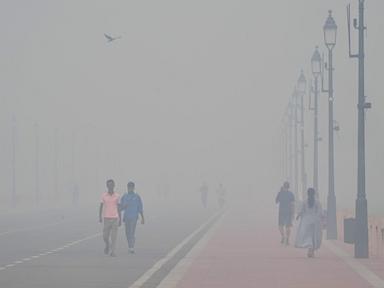New Delhi experienced a sharp decline in air quality on October 25, 2023, following the annual Diwali celebrations. Millions of residents celebrated the Hindu festival with fireworks, resulting in alarmingly high levels of air pollution across the city. Firecrackers set off late into the night filled the atmosphere with smoke and fine particulate matter, worsening existing seasonal pollution exacerbated by stagnant weather conditions.
By Tuesday morning, the Air Quality Index (AQI) in several neighborhoods soared above 350, indicating a “severe” level of pollution that poses serious health risks, according to the World Health Organization. Visibility diminished significantly as a thick gray haze enveloped streets, residential areas, and historical landmarks. “I have never seen anything like this before. We can’t see anything here because of pollution,” said Vedant Pachkande, a tourist visiting New Delhi.
Firecracker Regulations and Their Impact
India’s Supreme Court recently eased a comprehensive ban on firecrackers in New Delhi during the Diwali festivities, permitting limited use of “green firecrackers.” These are designed to emit approximately 30% fewer pollutants, developed by various federal research institutes. The court specified that these firecrackers could be used during designated hours from Saturday through Tuesday, but this regulation was largely ignored, mirroring trends from previous years.
New Delhi, along with its metropolitan region, is home to over 30 million residents and frequently ranks among the most polluted cities globally, particularly during winter months when Diwali celebrations coincide with cooler weather and smoke from agricultural burning in nearby states. Authorities have implemented measures to mitigate pollution, including restrictions on construction activities and limits on diesel generator usage. Despite these efforts, environmentalists argue that sustainable solutions, such as transitioning to cleaner energy and enforcing stricter vehicle emissions standards, are essential for long-term improvement.
Long-Term Effects of Pollution
Recent studies indicate that rising pollution levels are not only harming air quality but also reducing the amount of sunlight reaching the Earth’s surface in India. Research published in Scientific Reports highlights a steady decline in sunshine hours across most of India due to increasing aerosols from industrial activities, biomass burning, and vehicle emissions. Manoj K. Srivastava, a scientist at Banaras Hindu University and co-author of the study, noted, “We see a greater impact in more polluted regions such as northern India.”
This reduction in sunlight could have significant repercussions for solar energy production and agricultural productivity, alongside adverse effects on public health and the environment. As New Delhi grapples with the aftermath of the Diwali celebrations, the urgent need for effective, long-term solutions to combat air pollution remains a critical focus for both policymakers and citizens alike.







